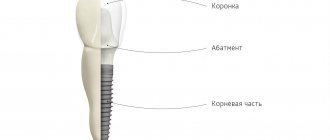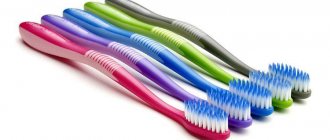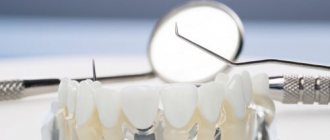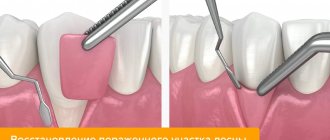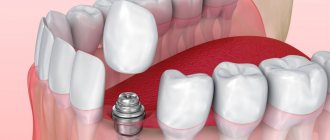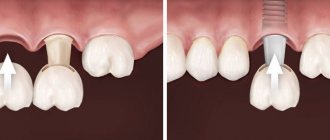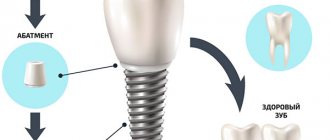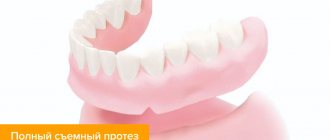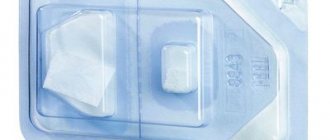What is dental implantation When do you need an alternative How can you replace implants For chewing teeth For front teeth With complete edentia Why do you need to restore teeth Which method is better
Patients are looking for an alternative to implantation due to financial or clinical restrictions on the implantation of artificial roots. Removable dentures (clasp, flexible, acrylic) and fixed products made of metal ceramics, all-ceramic, zirconium (dental bridges) can not fully replace implants. Rarely, missing units are replaced by displacing adjacent ones using braces. The preferred option is implantation: it guarantees an aesthetic, long-term and reliable result, with safety for neighboring units and benefits for the jawbone.
When an alternative to dental implants may be needed
Not everyone can get implantation. Contraindications for surgery:
- mental pathologies;
- immunodeficiency states;
- cancer;
- decompensated diabetes mellitus;
- rheumatism;
- problems with blood clotting;
- diseases of the central nervous system;
- diseases of bone tissue;
- inflammatory processes;
- severe heart pathologies;
- renal failure;
- increased sensitivity to antiseptics;
- age up to 18 years.
The list of contraindications varies depending on the implantation method. In addition to the restrictions on installing titanium roots, implantation has other disadvantages:
- relatively high cost of treatment;
- risk of implant rejection;
- the likelihood of damage to the maxillary sinuses (with prosthetics in the upper jaw row);
- complexity of the operation (the integrity of soft, bone tissue, nerve endings and mucous membranes is damaged - postoperative swelling and pain occur).
The role of the doctor in choosing a treatment method
Often, already at the first consultation, the patient categorically declares: “I need an implant!” It sounds so confident that it seems that only the lack of appropriate tools is keeping the patient from doing it himself.
Before receiving the right to treat patients, a doctor studies for 6 years, then for 2 years he can undergo highly specialized training. Every 5 years he goes to improve his qualifications, but in fact he studies all his life, constantly gaining new experience, skills and knowledge. What can be concluded? Only a doctor can draw up an optimal rehabilitation plan and carry out the necessary manipulations.
Before starting treatment, a comprehensive clinical and radiological examination is carried out, and if necessary, the patient is referred for consultations to doctors of related specialties. Not only the extent of the dental defect is assessed, but also the condition of each remaining tooth, the quantity and quality of bone tissue, and the presence and severity of the patient’s general diseases. Only then will it be possible to make a diagnosis and formulate a treatment plan. Of course, the patient should be fully informed about both the treatment plan and alternative methods.
In conclusion, we would like to advise patients who have not decided on the choice of treatment method and who have no serious contraindications to pay attention to dental implants.
What can replace dental implantation?
Removable dentures
If the patient does not have money for implants, they make do with removable dentures, which can be inserted and removed from the mouth without the help of a dentist. The type of structure being installed determines the number of lost units:
- there are not several units in a row - partial structures are needed;
- If you need to replace your teeth, a full removable structure will help out.
The design of the removable product is made of plastic pink gums and artificial teeth. The structure includes a metal frame, hooks, and locks. If a complete denture is fixed, due to the gingival base, the product adheres to the mucous membrane (for reliability, patients use fixing creams and gels). The partial denture rests on healthy units with the help of hooks and clasps.
There are types of dentures:
- Bugelnye. The structures are used to restore several elements. They have a metal arc or clasp. The product is durable and can be fixed even on moving teeth. The service life of the structure is 7 years or more. Among the disadvantages, they note: low aesthetic value (fastenings are noticeable), relatively high price of prostheses. Condition for prosthetics: the presence of at least 2 supporting teeth in each row.
- Flexible. Dentures are made from soft hypoallergenic plastics - they are lightweight, comfortable to wear, and fit well to the gums. Partial flexible structures are supplemented with fastenings - plastic hooks. Products last 5-7 years or more. Among the disadvantages, they note: the impossibility of repairing or adjusting the prosthesis in the dentist’s chair (the product is repositioned by a dental technician). When wearing a soft structure, the atrophic process in the bone progresses faster (compared to a hard one).
- Acrylic. Plate structures are made of hard plastics - they are not comfortable to wear. The chewing load will be distributed on the gums, and not on the supporting units. Plus - low cost. Of the minuses, they note: the length of the period of adaptation, methyl ester of methacrylic acid in the composition of acrylic (irritates the mucous membranes).
Fixed dentures
Fixed structures are fixed in the oral cavity - the patient cannot remove them without the help of a dentist. The prosthesis has the form of a single dental crown or complex (dental bridge), which is “put on” the supporting teeth.
Bridge-like products rest on healthy neighboring elements (they are pre-ground). A locking dental bridge in the form of a single crown has a latch inside (the other two are on adjacent teeth). The adhesive structure is fixed to the supporting units, not covering them, but joining the tooth wall (preparation is excluded).
Fixed dentures have the following advantages:
- instantly restore the aesthetics and functionality of the dentition;
- biocompatible, hypoallergenic;
- do not rub the mucous membrane, do not create the sensation of a “foreign body” in the mouth;
- wear-resistant.
The disadvantages of fixed prosthetics include the high price and the need for support in the form of healthy teeth. In the absence of a large number of units, this support can only be implants.
Depending on the material, non-removable products are classified into:
- All-ceramic. The dentures are made of pressed ceramics; they are durable and resistant to chips, scratches and discoloration. The products are successfully used in the restoration of the frontal row.
- Metal-ceramic. One-piece construction consisting of a metal base and a coating in the form of aesthetic porcelain. Durable products can withstand significant loads. An allergic reaction to the metal is possible. Suitable for restoring chewing teeth.
- Zirconium. The basis of the design is zirconium dioxide, the coating is a layer of dental ceramics of a selected tone (similar to enamel). The prosthesis is durable, fits tightly to the supports, CAD/CAM technology guarantees the accuracy of the restoration. The disadvantage of zirconium prostheses is their high cost.
Recover adjacent teeth with braces
An alternative to implants and a bridge to replace the lateral teeth is to move adjacent units to replace the removed ones. The duration of therapy depends on the number of missing teeth and the time the patient walked without them. Treatment can last up to four years.
Before therapy, a thorough diagnosis is carried out and probable changes in the bite are predicted. Possible complications of therapy include resorption of bone tissue and exposure of tooth roots.
Why is implant-supported prosthesis considered the best solution?
I.
The dental implant method allows you to restore lost teeth using single crowns, bridges and full dentures supported by implants. Such a prosthesis, even in the absence of all teeth, completely restores chewing function.
II.
The implant completely replaces the root of a natural tooth: it receives the load from the crown and distributes it to the bone tissue, so that it does not undergo atrophy. Simply put, with the help of dental implants, the doctor restores the natural function of chewing to the fullest extent possible. Feedback from patients about implantation, especially from those who have previously used prostheses of other designs, will be positive in the vast majority of cases.
III.
The service life of an intraosseous dental implant (if its installation was carried out efficiently) is practically unlimited. We see patients who had implants installed more than 30 years ago. Particular attention should be paid to self-discipline and compliance with all rules of oral hygiene. The patient must understand that the presence of implants increases the requirements for daily hygiene (using not only a toothbrush, but also an irrigator) and implies regular (2 times a year) professional oral hygiene. Thus, the long-term functioning of implants is not only the competent work of the doctor, but also the responsible attitude of the patient himself to his health.
What is an alternative to implants for chewing teeth?
The chewing elements are more loaded than the anterior ones. The anatomy and localization of the units makes it difficult to care for the elements - the risk of developing dental diseases in the area of chewing teeth is high, the elements are susceptible to destruction.
If one or more teeth are missing in the chewing area, a dental bridge is placed, provided that there is something to attach it to - the adjacent units (including damaged ones) are pre-ground.
Among removable products, the use of a clasp design is justified - a durable option that does not bend under load. The product is secured with hooks or clasps.
Stages of treatment - high quality, not scary and without pain
The surgical operation to install or replace an implant, from the point of view of an experienced implant surgeon, is considered simple; effective local anesthesia is often used.
If the patient wishes, the operation can be performed under sedation. During primary implantation
: in modern dentistry, painless tooth extraction is practiced before an implant; an implant is immediately placed in the resulting hole. The express method is popular and is considered gentle for the patient.
When replacing an implant
: if an implant is removed, a high-quality innovative system will be installed instead of the removed artificial tooth.
Almost 100% of re-interventions are successful. The procedure is divided into stages
:
- the finishing crown is removed (if any),
- the ineffective implant is removed from the bone tissue,
- the cause that caused the pathological processes is eliminated,
- a new implant is installed.
In case of severe complications resulting in removal of the implant, the operation to install a new tooth is expected after some time - a maximum of 2 months.
How to replace implants on front teeth
The frontal elements are not involved in chewing food, but high aesthetic demands are placed on them. As an alternative to implantation, a dental bridge is suitable for restoring teeth in the front row.
Metal-ceramic structures are not used in the smile area: the metal base darkens in the light; upon contact with metal, the mucous membrane may darken. Solid ceramics is a durable material, characterized by natural translucency, and looks like “your own” tooth. The most accurate, aesthetic and durable option is a zirconium dioxide prosthesis.
Dentist consultation
At the first consultation, the chief physician of Dial-Dent, S.V. Zukor listened to the patient’s complaints and identified the following defects:
1. Unnatural appearance of the front teeth, restorations do not look natural, the roots of some teeth are exposed, yellow tint of the teeth, visually increasing the age of the patient.
2. Clasp dentures with an arch along the upper palate complicate the perception of taste, make the prosthesis heavier, and create discomfort in the oral cavity.
3. Metal-ceramic crowns installed on the upper front teeth and lower chewing teeth are obsolete and chipped in places. Their service life exceeds 10 years - this is a long period for crowns made of this material. The lower central teeth are worn down and one of the lower teeth needs to be removed.
4. Lost teeth, but not replaced with adequate prosthetics.
Which method is better to choose?
Implantation is a privileged way to restore lost elements in the absence of financial and clinical restrictions. Advantages of the method:
- Implants are durable. When installing a dental bridge, a replacement will be required after 5-7 years. The service life of implants is at least 25 years .
- Adjacent elements remain untouched. Implants do not require support. When installing a dental bridge, the supporting units are pre-ground, which leads to their destruction.
- Stopping bone atrophy. Implantation guarantees an even chewing load on the jawbone - the bone is not destroyed.
- Preservation of taste sensations. Removable structures dull the sense of taste due to the massive base blocking the receptors.
- Reliable fixation of prostheses and installation of various options for orthopedic structures.
Author of the article Voznyuk Vladimir Aleksandrovich Maxillofacial surgeon-implantologist of the highest category
Experience more than 30 years
Content
- How can you replace dental implants?
- What to choose?
The popularity of installing implants in dental clinics is growing every day. Information-savvy patients have realized the numerous advantages of this method and prefer it in cases where it is necessary to restore a missing tooth in a row, several teeth or a completely bare jaw.
There are still categories of people who do not choose implantation. Among them:
- Those who are afraid of any surgical intervention and cannot overcome their fear, even realizing the need and benefits of installing implants.
- Those who are guided by financial considerations. They are trying to find a cheaper option for dental restoration, giving up the benefits of implant technology. Let us immediately note that the validity of such considerations is very conditional. A bridge lasts 10 - 15 years. A bridge on implants lasts a person’s entire life.
- Those who have absolute contraindications to dental implantation. Among them are patients with serious diseases of the body, for example, the cardiovascular system, endocrine system, and respiratory organs. It is necessary to look for an alternative to dental implantation for those who are intolerant to anesthetics.
Also, the question of how to replace a dental implant is relevant for those who have already undergone implantation, but due to complications that have arisen, the installed titanium rod has been rejected, and its re-installation is not possible.
PROMOTION
Osstem dental implantation turnkey
18,000 rub.
